BUILD PODER's Legacy: Transforming Student Research at CSUN
By Sonia Hiew

CSUN BUILD PODER’s first cohort at their summer jumpstart program in 2015.
At California State University, Northridge (CSUN), a transformative era is drawing to a close as the Building Infrastructure Leading to Diversity, Promoting Opportunities for Diversity in Education and Research (BUILD PODER) program completes its 10-year mission this spring. BUILD PODER is an undergraduate research training program established in 2014 with 10 years of grant funding from the National Institutes of Health.
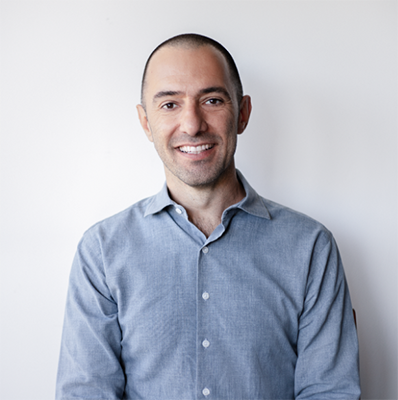
Crist Khachikian is a BUILD PODER principal investigator who leads the Administrative Core. He is also a PI on the NSF ESTUDIO grant.
Though the program is ending, BUILD PODER leaves behind a legacy through CSUN’s Excellence in Student Training for Undergraduates, Diversity Initiative Office (ESTUDIO) and the newly established Office of Undergraduate Research (OUR).
BUILD PODER principal investigator Gabriela Chavira, PhD, and co-investigator, Crist Khachikian, established ESTUDIO with a $3 million grant from the National Science Foundation in 2022.
“The point of that grant is to take all of the training that was developed through BUILD and institutionalize it, make it available to all STEM students on campus,” Khachikian said.
After they were awarded the grant to establish ESTUDIO, Chavira was hired as the inaugural director of CSUN’s new Office of Undergraduate Research (OUR). Chavira said she saw this as an opportunity to incorporate ESTUDIO under OUR.
“As the director of OUR, we’ll be able to house all the workshops and student training that we developed under BUILD, not just for STEM students but for all students across the university,” Chavira said.
BUILDing Beyond the Grant: The Office of Undergraduate Research (OUR)
Chavira envisions OUR as a one-stop hub for students seeking research opportunities.
"CSUN has traditionally been a teaching institution where students come, take classes, and enter the workforce,” Chavira said. “Many students don't know how to find research activities; there's no one place where they can go. We're putting all these resources under one office–OUR."
OUR, launched in fall 2023, aims to support students in mentored research experiences, connect students with graduate and faculty mentors, and facilitate funding opportunities.
"We want OUR to be a resource for faculty to find students who can work on their research activities and for students to receive entry-level training, find a potential mentor, and secure some funding to engage in research opportunities," Chavira said.
OUR is a collaboration with the Financial Aid and Scholarship Office to support the Learning Aligned Employment Program (LAEP), a work-study initiative funded through the California Student Aid Commission. LAEP provides paid mentored research opportunities for students throughout the academic year.
ESTUDIO will focus on STEM fields by preparing STEM students for research activities and supporting students and their mentors.
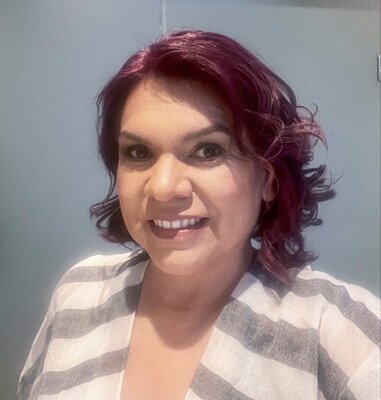
Gabriela Chavira is a BUILD PODER principal investigator who leads the Student Training Core and is a PI on the NSF ESTUDIO grant.
Although OUR currently exists in a virtual space, it is will move into a physical location at the garden level of the University Library, which BUILD PODER occupies presently. They plan to relocate to the future Matador Success and Inclusion Center. which is expected to open in 2027-2028.
Chavira said OUR’s overarching mission is to make research endeavors accessible and stress-free for students and faculty.
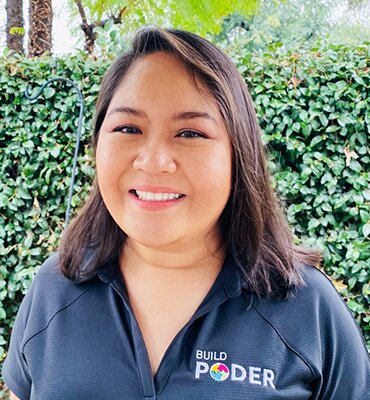
Patchareeya (Patty) Kwan is a BUILD PODER principal investigator leading the Research Enrichment Core.
"We hope that students come to OUR for resources and support, and we hope faculty refer students to OUR,” Chavira said. "We know that mentoring students and being involved in research is time-consuming and labor-intensive, and we hope that we alleviate some of the stress for faculty and students through the resources we provide."
As they navigate this transition, Patty Kwan, PhD, a BUILD PODER PI, supports these initiatives. She emphasized the importance of university administrators recognizing the value of their work.
"We're hoping that the university administrators will see value in what we do, and we can share with them our evaluation results," Kwan said.
She also highlighted the long-term vision.
"We hope [university administrators] take it and they'll say ‘OK, we know it's working, we know faculties like it, let's adopt it and find money to support it because it's something that we want to continue even when BUILD is not around,’" Kwan said.
Sustaining Research Excellence at the Institutional Level: From Lilac Hall to HERE Center
Carrie Saetermoe, PhD, a principal investigator of BUILD PODER who initially led the Research Enrichment Core (2014-2019), underscores the critical nature of disseminating BUILD PODER throughout CSUN on the institutional level. She points out that many programs focus predominantly on individual students. However, the long-term impact on the institution is often limited once the funded program concludes.
“We helped those individual students, but when those students leave, the institution has a little bit of social capital or human capital because usually the faculty gets some kind of training or the university gets a little bit of equipment, but not much stays after the grant goes away," Saetermoe said.
In response to this challenge, BUILD PODER has strategically implemented initiatives at the institutional level to ensure sustained research excellence. One significant outcome is the establishment of Lilac Hall, a 10,000-square-foot building that stands as the first and only on campus entirely dedicated to research.
Khachikian highlighted the purpose behind Lilac Hall.
"Part of BUILD was to support students, but a part of it was also to increase capacity among faculty, for faculty to do research," Khachikian said.
Lilac Hall is a tangible representation of BUILD PODER's commitment to fostering a research-focused environment, creating a space for BUILD students, staff, and essential resources.

CSUN’s Lilac Hall, where the HERE Center is located.
Another notable outcome of BUILD PODER is the Health Equity Research and Education (HERE) Center, located in Lilac Hall. Saetermoe founded the HERE Center, where the health equity cluster hires do their research. The HERE Center is a central hub for community collaboration and health equity research initiatives.
Through the HERE Center, collaborations with external entities, such as the Department of Public Health on the African American infant and maternal mortality initiative, have been established. The center has been instrumental in developing products and publications that contribute to ongoing research and community engagement.
Empowering Faculty: The Next Frontier in Research Excellence

Gabriela Chavira, inaugural director of CSUN’s new Office of Undergraduate Research (OUR), giving an opening speech at its “Getting Into Research” event on Sept. 15, 2023.
Faculty members serve as the backbone of academia, steering the trajectory of research and academic excellence. However, they are often stretched thin as they navigate the myriad responsibilities that come their way.
Khachikian explains that one of the hopes of OUR is to remove the barriers to faculty engagement in research endeavors. One innovative approach involves guiding students through essential training modules through OUR.
"So let's say you're a student and want to do research with me,” Khachikian said. “That’s great, but if I don’t have time to get you up to speed, I could send you to OUR and take these trainings, and then when you come back to me, you're sort of at a different level and ready to engage. What we're hoping to do is through these modules and trainings is sort of reduce the time they need to onboard students.”
Diversity within faculty is another crucial aspect addressed by the BUILD PODER program. Saetermoe explained how BUILD made a lot of effort to integrate critical race theory into the faculty culture. She acknowledged the significant challenge of bridging the gap between a predominantly white faculty and a diverse student body.
"When we started BUILD, 70% of the faculty were white, and something like 70% of the student body were not white,” Saetermoe said. “So it was like this big gap, and so how do you change an institution where there's this big gap between faculty?"
Saetermoe emphasized the necessity of faculty involvement in understanding the unique strengths and experiences of students, particularly those from diverse backgrounds.
“CSUN students are individuals and they have what we call community cultural wealth, they have strengths that if I don't know as a faculty member how to make the most of, I can’t help my students become the best that they can be,” Satermoe said.
The health equity cluster hires, a groundbreaking initiative, involved recruiting four diverse faculty members focused on health equity in various departments. This strategic hiring approach is designed to build a lasting foundation for research excellence.
Kwan talked about the profound impact of BUILD on faculty-student dynamics.
“I think one of the best things I want to say BUILD has done for faculty and students is that we trained our faculty to really value our students' lived experiences and who they are,” Kwan.
Kwan shared how her own experiences as an instructor have evolved to better understand and value the lived experiences of students, fostering a more inclusive and supportive academic environment.
“I feel as if I've become such a better mentor to students and a better instructor to faculty because of the BUILD training,” Kwan said. “Because now I could see that maybe things happen differently for them. When a student says ‘I'm failing your class’ maybe it's not that they're lazy, maybe it’s because I'm not interacting or speaking in the way that makes it easy for them.
I think that's one of the things that we're disseminating that maybe it's not seen as concretely. But those are things I think are going to last well beyond BUILD."
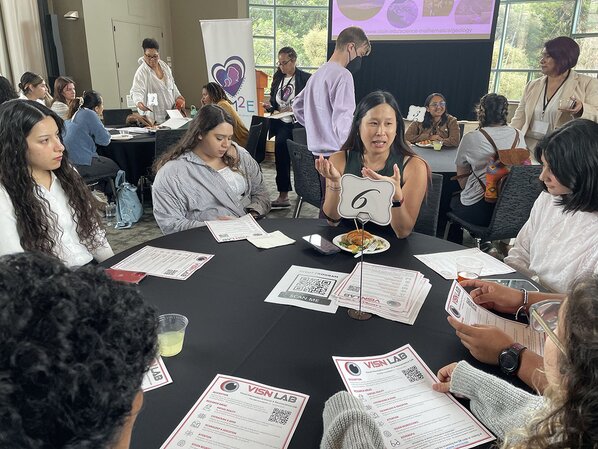
Stephanie Drew, PhD, discussing her lab with students at a roundtable session at OUR’s Getting Into Research event on Sept. 15, 2023.
A Student-Centric Approach: Nurturing Future Scholars
As BUILD PODER comes to an end, the leadership team is crafting a plan to ensure a sustained impact on future student researchers at CSUN.
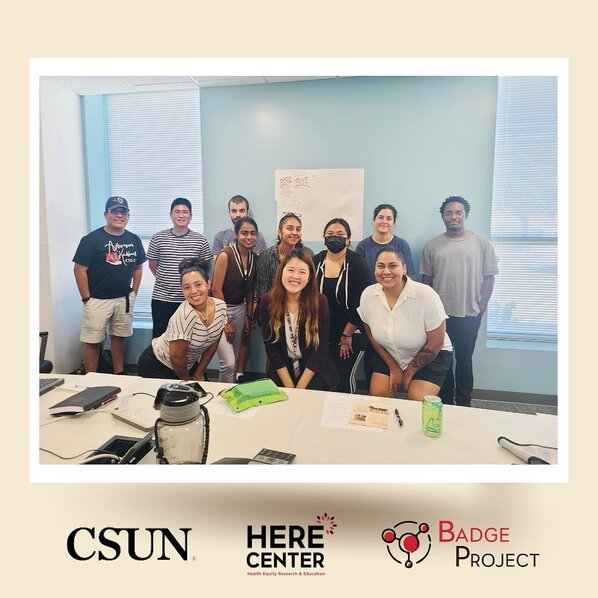
HERE Center Operations Manager Amber Bui (front center) with Badge Project Coordinator Elizabeth Gutierrez (front right) at an information session in 2023.
Khachikian shared that the student core initiative includes designing in-person, hybrid, and asynchronous training modules that will be hosted for all students.
One program that supports this aim is Badge Project, an integral component housed within the HERE Center. Kwan shared that the Badge Project imparts essential skills to students, that range from resume creation to effective communication with faculty, preparing them for success in their academic and professional journeys.
"We have disseminated out into the CSUN environment ways to be better mentors and ways to be more productive faculty members and ways to think differently about community," Kwan said.“The goal is not just to equip students with skills but to foster a culture of mentorship, productivity, and community engagement that will endure beyond the BUILD program.”
The legacy of BUILD PODER is not merely a set of activities, but a commitment to empowering future scholars across disciplines, ensuring they are well-prepared, supported, and equipped for success.
The program’s impact on the academic landscape of CSUN promises to be profound and enduring.
The Coordination and Evaluation Center at UCLA is supported under award number U54GM119024.

Grow Together.
